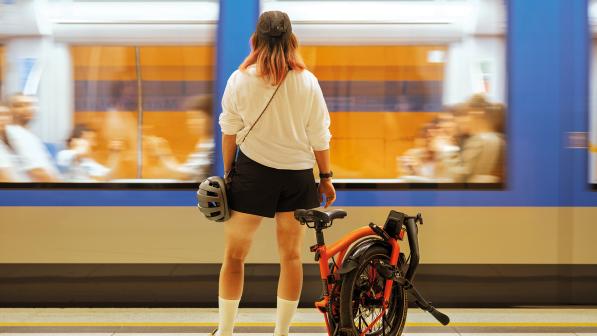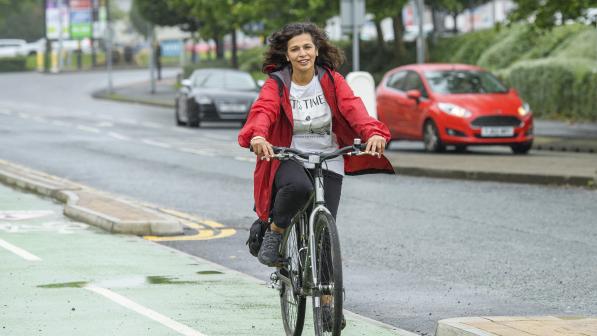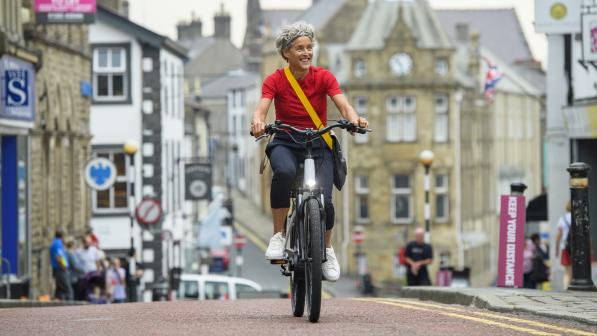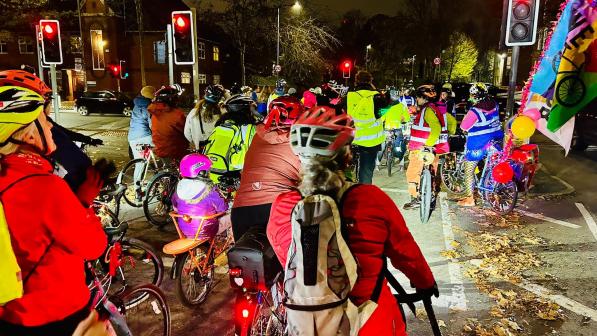Mind the (cycling gender) gap

Sophie Gordon, Cycling UK Campaigns Manager
There’s a long way to go before cycling is seen as a ‘normal’ mode of transport in the UK – especially by women, who cycle half as often as men. If you look at countries where more people cycle, it’s around a 50:50 split. So what are we doing wrong?
I’ve heard a lot of different perspectives on that over the past few months, and the biggest factor that keeps coming up is the perception that it’s unsafe. We know that, overall, cycling is a safe, convenient, healthy way to get around. Yet it doesn’t always feel like that.
Cycling UK’s recent YouGov research found that 58% of women believe their cycle journeys are limited by safety concerns and a lack of suitable infrastructure.
The thought of sharing roads with large vehicles and of having to negotiate busy junctions and roundabouts can feel off-putting for many people, but it’s especially significant for women.
As one woman I spoke to said: “For me it’s a combination of lack of confidence and poor infrastructure. The safe cycle routes near me are not joined up, and are crucially missing at the most congested areas of road.”
Another noted that, for many women, there is also the concern about harassment or abusive behaviour, particularly after dark. She said: “At different times in my life, I’ve had to really think about the route I’ve taken to cycle, especially during the winter months when it’s dark.
“It’s so important that, when routes are designed, they take into account the issues women face when it comes to safety.”
When London Cycling Campaign audited routes in the capital, it found a quarter of them ‘socially unsafe’ after dark. Cycling UK staff joined one of LCC’s protest rides, highlighting this issue.
Women often aren’t just thinking of their own safety. As one parent said: “More women are in charge of transporting kids as well as themselves. And fragmented, narrow and non-protected bike lanes are not safe enough to ride with children.”
Feeling so lifted to have connected with so many wonderful women who seem to get me and have been so relatable. I can now go home and push myself harder to ride further from home and see new places with new confidence
Lois, rider on Adventure Syndicate’s Cairngorms ride
Cycling UK’s ‘My ride. Our right’ campaign aims to change that:
- We’re pressing for long-term investment in cycle routes from governments across the UK.
- We’re pushing for better promotion of the updated Highway Code, to foster more respect on the roads.
- We’re asking councils to listen to women’s voices when planning and designing routes, to make sure the infrastructure works for them.
- We’re highlighting low-cost changes that can make big differences to perceptions of safety, like improving lighting, reducing speed limits and making sure bike parking is in public view.
We need to ensure councils and politicians understand that by making places more appealing for women to cycle, they will make them better for everyone. You can help by using our quick tool to contact your representatives and ask them to support the campaign.
I remember one comment that summed this up nicely: “I cycled through Newcastle last summer and they are getting it right. It was a delight, with lots of women cyclists!”
Lee Craigie, Adventure Syndicate founder
The Adventure Syndicate was formed in 2015 with the aim of encouraging more women and girls to ride bikes.
A small collective of proficient female bike riders had had enough of being told by social media channels and the marketing departments of the cycling industry that riding bikes was a serious and complicated business – one where sleek, lithe men in Lycra with chiselled jawlines gritted their perfect teeth against extreme gradients in grim, high-alpine weather.
This narrative suggested that in order to belong to this exclusive cycling community, you had to be willing to suffer and usually to suffer solo.
But the founding members of the Adventure Syndicate (who were no strangers to suffering themselves) were concerned that, while this might appeal to a few aspiring bike racers, it did nothing to promote the joy and the community to be found in cycling.

The bike industry’s answer to our concerns was to make men’s apparel smaller and add pastel colours to make women buy it. Shorter, slower rides with cake incentives were thrust at women in the hope they might like to join their boyfriends on a rest day.
No sweating, no bulging thigh muscles. The problem was that there were very few non-male voices in cycling at the time. Female cycling was being distilled down and represented as a caricature.
We needed real women – a range of them in different shapes, sizes and colours – to express the reasons they loved to ride bikes so that other people, whatever their gender, could see that the cycling space was a diverse and welcoming one where you only had to discuss gear ratios if you really wanted to.
For over a decade we have been running events, talks and workshops that aim to tell bike-related stories full of humour and fallibility that anyone can relate to; adventurous stories that inspire connections with oneself, others and our natural world.
Isn’t it brilliant to get together with like-minded, strong, extremely capable and inspiring women? I managed so much more than I thought possible this weekend and I’m so glad I took on the challenge
Becky, rider on Adventure Syndicate’s Cairngorms ride
Our latest event involved a three-day circumnavigation of the Cairngorms. These were challenging, long days of remote mountain bike riding that participants had to navigate themselves, ending at comfortable hostel accommodation where food was shared and friendships consolidated.
In this way self-reliance was encouraged but so was camaraderie. Fourteen women ranging in age from their 20s to their 60s turned up to this event because we dispelled any myths about needing to be superheroes with all the right kit to take part. Every one of them proved themselves more heroic than the guys in those cycling ads.
The other interesting outcome of our storytelling is the growing number of men who appreciate the alternative narrative we offer. We get messages from lots of men wanting to be part of the fun, and so now many of the events we run (although always female led) are open to any gender.
Rosie Wilson, founder of a women’s and gender minorities’ club
I set up Lunar Cycles because, riding with other clubs, I was often frustrated at being the only woman on a ride. The vast majority of cycling club members are men.
I would also sometimes have my bike and equipment not-so-subtly assessed, and be on the receiving end of mansplaining. I’ve been given unsolicited advice even on the height of my saddle.
I realised there was a gap for women who do a lot of cycling (commuting, touring, road riding), who are passionate about the pastime and want to cycle with others but do not feel that a regular club is for them.
While there are some initiatives for women in cycling, they tend to be aimed only at beginners. Lunar Cycles fills the gap by providing a space for, and increasing the visibility of women and minority genders in cycling – as well as trans and non-binary folk.

Club member and ride leader Sophi-Louise said: “Joining Lunar Cycles has been such a refreshing experience after trying so many other clubs where I never quite felt like I fitted in.
“It’s helped me rediscover my love for cycling after a long break by rebuilding my confidence. I often found male-dominated groups overwhelming and full of unsolicited advice. But Lunar Cycles has been completely different – friendly, welcoming and open.
You can ask questions without feeling silly, and the club’s ethos creates a calm, supportive atmosphere.”
A study conducted by Cycling UK found that, compared to seven years ago, while men feel safer on the road, this has not changed for women. This is unfortunately not surprising. Like most city infrastructure, cycling infrastructure does not consider the ways women move around cities, and the differing threats to our safety.
Never let your gender define what you think you are capable of. I hear women saying all the time ‘I’m not strong enough, I can’t get up that hill.’ Guess what? We are always strong enough! Believe! The best endurance athletes in the world are women
Lucy Ritchie, Serre des Ormes participant
Beautiful, separate cycle tracks like the Bristol-Bath railway path do exist but only in places. After dark I am faced with decisions like whether to brave an underpass where I’ve been followed, whether to use a bike path on which I’ve received sexual harassment, or instead cycle across a major roundabout to avoid this, thus facing a different threat to my safety.
I was hit by a car last summer as the driver saw me as ‘in his way’. It’s a catch-22 situation that most men do not have to consider.
Additionally, groups of women and gender-minority cyclists face more aggression or unwarranted comments (often sexualised) than groups of mainly men. One driver, who had to pull into a lay-by so we could pass, blurted that we were “naughty”. Can you imagine a male driver calling a group of male cyclists ‘naughty’?
It’s clear that some road users still don’t accept that it’s our right to be on the road. We want to change that. Lunar Cycles rides always provide a sense of freedom. We discover beautiful routes, the chats are great, and cake is always a main feature.
Lunar Cycles is more than a cycle club: it has become a community, and we continue to fight for our right to safe and enjoyable cycling.
Kate Maddison, cycling holiday operator
Over the last two years, 50% of our guests at Serre des Ormes have been women. Unfortunately, this figure is not the general trend across the UK.
In terms of advice for female cyclists, which they might not be given by a bike hire centre or shop, below are the things that I think make the most difference.

Getting a good saddle and adjusting the height and angle to suit you is essential. We have a range of saddles for guests to try when they are here. The saddle is one of the main points of contact on a bike, and a single day on a hard, male-specific saddle can be agony.
Many bike shops don’t measure for saddle fit when women buy bikes, or even talk about it at all. I am amazed by how many women who have been cycling for a long time nevertheless assume saddle discomfort is unavoidable.
Cycling means freedom to me. Every ride is an adventure, a chance to enjoy the outdoors and the sense of accomplishment that comes with reaching new destinations
Laura Woods, Serre des Ormes participant
Women’s hands are generally smaller. Adjust the distance of brake levers from the handlebar so you can reach them easily while still gripping the bar. Most levers can be adjusted inwards, either with shims or by an adjustment screw, depending on the type.
Sore hands seem to be a common problem, too. Using the drops on a road bike gives much more control on the descents and makes braking easier.
Believe in yourself and don’t worry about holding other people up. We have noticed that, among men and women of the same ability, women are often less confident and more worried about holding up others. Yet they tend to be better at pacing themselves over the whole ride.



